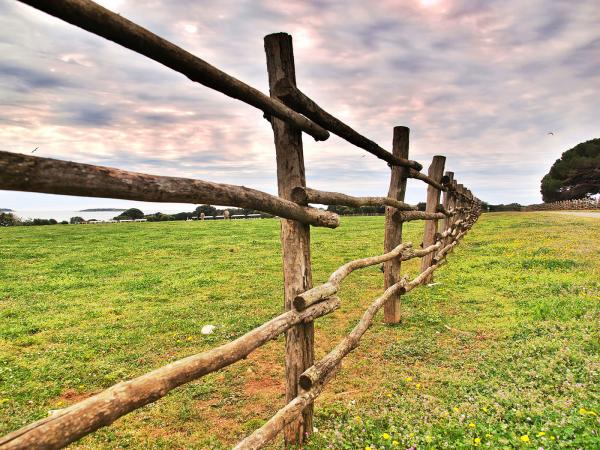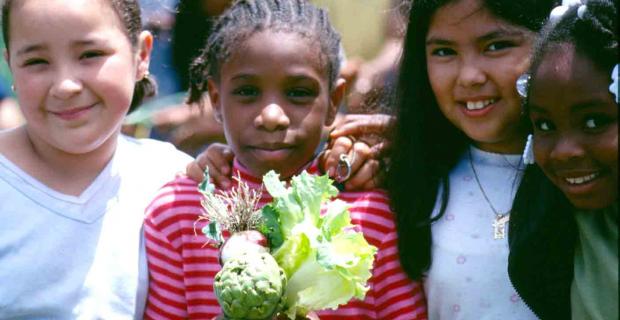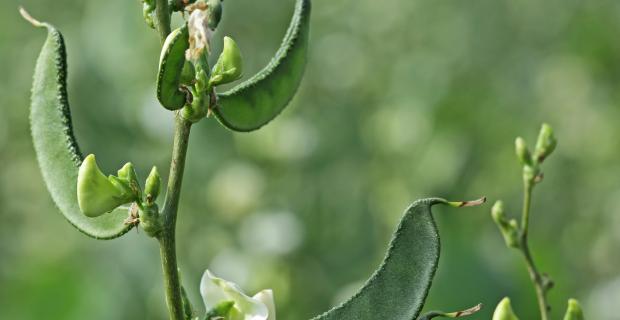Reforming Farming to Fight Climate Change: An Interview with Michael Pollan

Rene Ebersole: Should we be looking more closely at how the food we eat affects the climate?
Michael Pollan: I think there’s a growing recognition that you can’t really address climate without looking at the food system. Yet, exactly how you do that, what that means from a policy point of view, is a lot more complicated than regulating coal-fired power plants.
RE: Agriculture is a large source of global warming emissions. Yet you propose that it can help reverse climate change?
MP: We certainly need to mitigate the amount of carbon and methane and nitrous oxide that agriculture adds to the atmosphere, but we can do much more than mitigate, because we can use agriculture to sequester large amounts of carbon. In fact, a third of the carbon in the atmosphere today was originally in the soil. Not in the form of fossil fuels but in the form of soil carbon.
RE: So you’re saying farming can recapture carbon in the soil?
MP: The body of science telling us exactly how to do it is still fairly undeveloped. There’s lots of experimentation going on, but farmers can show you that a patch of soil over there used to be exposed rock, and now there’s six inches of soil. Much of that is carbon.
We usually talk about sequestering carbon in plants, and we know now how trees do it. When plants die, many of their parts break down and enter the soil as carbon. But what most people don’t realize is that the roots do it, too, and may do it in a more permanent way. It all has to do with the plant’s production of sugar, much of which leaks into the soil through the roots. What happens is when grasses grow they feed sugar to beneficial microbes that live around the rhizosphere, or root zone. In exchange the microbes supply other nutrients, minerals in particular, to the plant. This is how carbon enters the microbial ecosystem and goes through the food chain. Depending on the kind of microbes you have, they can store carbon in a very stable form, where it remains in the soil for an extremely long time.
The other way carbon sequestration happens is when plants are grazed by ruminants. Plants shed, or kill off, a certain amount of root mass to match the mass they’ve lost to the ruminant. They’re trying to keep their roots and shoots in balance. The roots they shed are broken down by worms, nematodes, microbes, and fungi and turned into soil organic matter. That’s how organic matter originally was formed.
We began losing this bank of soil carbon 10,000 years ago, when we started agriculture. And even more dramatically after we started using a plow. Because as soon as you break the skin of perennials that cover the soil, you stimulate microbial activity that releases a lot of carbon into the air. So the challenge is whether we can reverse that. The evidence is pretty good that, at least to some extent, we can.
RE: What about the mitigation part of the equation?
MP: We have to look at a few things. The food system is responsible for somewhere between 20 percent and 33 percent of all greenhouse gas emissions. People argue about that figure, and a lot of it has to do with how you count the carbon emitted by the meat system. It also depends on if you include deforestation, which is part of agriculture, too. The part that people know the least about is what the fertilizer contributes to the problem. When you use synthetic nitrogen fertilizers (ammonium nitrate is the main one), what the plants fail to take up can turn into nitrous oxide when exposed to water, and that goes into the atmosphere. Nitrous oxide is like methane – it’s a much more effective gas at trapping heat than carbon dioxide. Plus, the way the fertilizer is manufactured involves a very high-heat, high-energy process.
Cutting down on nitrogen fertilizer would be one of the best things we could do to mitigate agriculture’s contribution to the climate change. It would also have the additional effect of improving soil health, because when you spread a lot of nitrogen fertilizer on the soil you basically make it salty, which kills many of the microbes.
To give you an idea of how serious this fertilizer problem is, when Wal-Mart decided they wanted to measure their carbon footprint as a corporation, they looked at everything — transportation, factories, the building of the stores, heating and air-conditioning, packaging — and discovered that their single biggest contributor to climate change was the fertilizer being used to grow the corn that was getting turned into the whole range of products that they sell, from Coca-Cola to meat and pet food.
RE: Are there particular types of agriculture that sequester more carbon than others?
MP: We know that organic agriculture sequesters more carbon than conventional; that perennial agriculture sequesters a lot more carbon than annual agriculture; that tilling releases carbon into the air, so it needs to be reduced if we’re going to sequester more carbon; and that raising animals properly on grasses, which is to say, rotationally – moving them frequently and giving the grass time to recover – sequesters very large amounts of carbon. I think there’s a terrific reservoir of hope here that we’re not paying nearly enough attention to.
RE: So organic farms can do this, but what about Big Ag?
MP: You don’t have to go to organic to reduce agriculture’s environmental footprint. History tells us what’s possible. Beginning in the Depression, we created incentives in our farm program to curb soil erosion. We offered farmers incentives not to plant hillsides, and leave them in perennials. We invented soil management strategies. We required our farmers to take advantage of a certain number of USDA programs to protect soil–the big environmental problem of that time.
Today the big environmental problem relating to agriculture is climate change. So why can’t we have a set of programs that give farmers incentive to, for example, not till? Most farmers will tell you that they use about twice as much synthetic nitrogen fertilizer as recommended because they see it as a form of crop insurance. We should put a tax on the excessive use of fertilizer — above a certain amount per acre you have to pay more for it. We could pay farmers for cover cropping — keeping plants on their fields through the winter. (The more you leave land black over the course of the year, the more carbon you’re losing.)
Even in conventional farms, if we organized our agriculture policies with the aim of dealing with climate change, there are a whole lot of things we could come up with to encourage farmers to build soil carbon. Plus, we could invest significant amounts of agriculture research in addressing the problem.
RE: Is anyone doing this?
MP: In Australia today they have something called pasture cropping, where they actually seed annual crops directly into perennial pastures. They time things very carefully so that the annual you’re putting into the pasture gets a head start on the perennial grasses around it. To put barley or corn right into a pasture – you get your grain and at the same time you’re leaving the land covered the entire time, and in the process you’re sequestering lots of carbon. There are tens of thousands of acres in Australia that are now being managed this way.
RE: What about regulation?
MP: The Obama administration is starting to regulate methane production in the energy sector. But on the agriculture side, where most of the methane is produced, the program is strictly voluntary — which is crazy. Our feedlots are a very serious source of methane in the atmosphere, yet there is absolutely no political will to regulate those feedlots and how they handle their water. But that’s where you could get some real bang for your buck in terms of limiting methane. And make no mistake: The federal government has the authority to regulate both methane and nitrous oxide gases under the same Supreme Court decision that it’s using to regulate carbon from coal-fired power plants. So it has the legal tools to do it. They just lack the will.
RE: In a 2008 article in The New York Times Magazine, you asked the question: Why bother? Then you laid out the case for making personal choices that can make a difference. Do you think consumer action can make a dent in this global threat? Or are we past that point?
MP: I think personal choices are necessary but not sufficient. One of the things that stands in the way of addressing climate change is that it’s so overwhelming to contemplate, and we can’t imagine making the necessary changes in our lifestyle. We know just how soaked in fossil fuel that lifestyle is. And a big part of the reason is the fact that we live in a highly specialized economy that fossil fuel has made possible.
Through our jobs we all contribute one particular thing to this economy. But then we rely on countless others to do everything else — to feed us, clothe us, entertain us, represent us in Washington, and so on down the line.
An economy that uses a lot less fossil fuel is going to require us to do a lot more for ourselves. We need to exercise that muscle. Because one of the reasons we feel so hopeless is that we can’t imagine growing our own food for ourselves, we can’t even imagine entertaining ourselves. But if we really are going to get fossil fuel out of our economy to at least some extent, we’re going to need to be somewhat less specialized and dependent on distant others. As soon as you exercise this independent action, you feel empowered and you can begin to imagine a different way of living.
Take something as simple as gardening, for instance. If we all grew some of our food, we could be sequestering carbon in our garden soils, and at the same time we could be reducing the need to go to the supermarket, and reducing the need to have food processed by industry. So I do think it’s both a real and a symbolic contribution. There’s no question that we need solutions at the macro level, too. But these changes at the micro level will lay the groundwork for those larger solutions. At least that’s my hope.
RE: As you say, it takes more than a handful of people eating local, line-drying their clothes, and changing light bulbs. So what, in your opinion, is the biggest societal change that needs to happen in order for us to combat this problem?
MP: Climate change is THE problem, so it needs to be the filter through which we examine everything we do. When we’re designing policies in every area we should view them through that filter. Is this policy helping or hurting with climate change? Every policy needs to be measured against that standard. It has to become part of the culture of governing. The same way we began doing environmental-impact statements, I think we need to do a very specific climate-impact statement for everything we do. It would be great to put a real price on carbon, but I think that’s only part of what needs to happen.
Also, social norms need to change, which, by the way, does happen — and sometimes very quickly. It was routine when I was a kid to throw things out the window of your car. And now that’s considered outrageous and beyond the pale. Smoking in public places, same thing.
RE: Is climate-friendly farming good for natural ecosystems?
MP: There’s a very interesting ideology afoot about what we need to do to feed the 10 billion people coming. It’s called “sustainable intensification.” Basically, the idea is that there’s a limited amount of farmland, so we should just grow the hell out of what we have — ramp up the yield to protect wildlife elsewhere and prevent encroachment of more farmland. Even though the word “sustainable” is used next to “intensification,” what that really means is agricultural lands should be treated as sacrifice zones, in that you do what you can and you use chemicals and GMO crops and you grow in monocultures and you create what are called clean fields, where nothing lives except your crop. And you do that on this fairly large percentage of the world that is farmland, so that you can protect wild things in other places.
We have one of those sacrifice zones in the Central Valley in California where we’re growing almonds in such a huge monoculture that there aren’t enough bees to fertilize them. So half the bees in America have to be transported to this intensified landscape every February, with the result that bees from all over the world mix and swap diseases. So what if that agriculture was a little less intensive, and had a little more biodiversity, so that pollinators would have plenty to eat for the other 50 weeks of the year when almonds are not in bloom?
Farms depend on ecosystem services, and if you intensify them too much, the ecosystem services fail. So I think the challenge is farming with the wild, rather than farming or the wild. Highly diversified farms are places where there’s lots of wildlife, and that also provide corridors from one wild area to another. It’s possible to combine really good productive farming with excellent habitat. We have the idea fixed in our heads that it’s nature or culture. The idea that you could mix them in any kind of beautiful or productive way is anathema in much American thinking, especially among environmentalists. This makes sense, since the roots of the movement are in the defense of wilderness.
RE: To quickly tackle climate change, must we all become vegetarians?
MP: We need a lot more vegetarians than we have. There’s no question that the amount of meat we’re eating – nine ounces per person, per day in this country on average — is one of the most significant parts of one’s climate footprint. And we need to reduce it because the rest of the world wants to eat meat the way we do. I do think there’s a place for meat eating, but it’s a lot tinier place than what it is right now. So the first thing is to cut down on your meat consumption, even if you don’t eliminate it. I think that’s more important than anything else you could do.
RE: What about the value of identifying and exploiting other sources of protein? Bugs, for instance.
MP: Well, there are a lot of good arguments that we should be eating more insects–because it’s a relatively sustainable form of protein.
But there’s a big taboo against eating insects in this country. Can we get over that? It’s going to take some really good marketing. We did get over it in the case of lobster, which was much like eating bugs in the 19th century. There were laws that you were only allowed to feed lobster to prisoners twice a week. Anything else was cruel and unusual because it was such a taboo food. And of course we got over the taboo of eating raw fish, which we now happily do. So it’s possible. Though just wait until they have feedlots for crickets. They’ll figure out a way to produce them so efficiently that there will be externalities that you won’t like.
RE: Last thoughts?
MP: We have seen the rapid growth of this alternative food system — both local and organic — come out of nowhere. Individuals are exercising their consumer choice in a very different way, letting their identities as citizens inflect their identities as consumers. And that’s a powerful thing. It may not be sufficient, as I said, but it is necessary. It puts us on the right footing to make political changes, and it’s practice for living a different way. So I take great hope from that.
Reprinted with permission from Audubon magazine, November–December, 2014.




